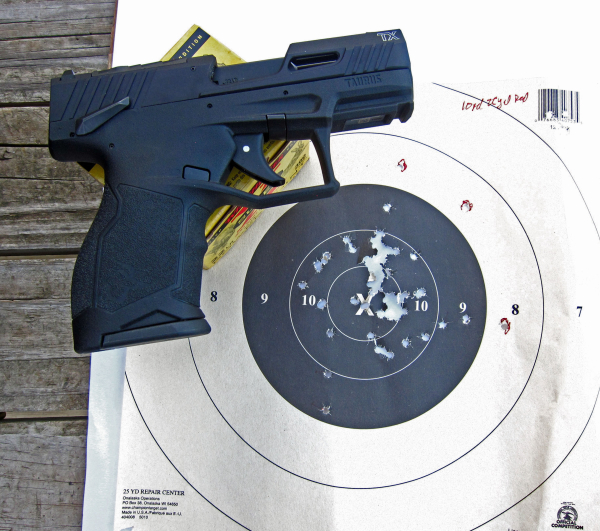Sometimes you may wonder what happens with products reviewed – how the product worked out over time. Earlier this year (reported here and here), I had the chance to work with the Taurus TX22 Compact 22 auto pistol. A 13-shot 22 LR, it has a polymer frame, a slide that’s cut out for weight savings and is machined for an optic … which I’ve still not mounted.
My concern was how good the gun is – as a plinker, field and trail gun, and a trainer – as it comes from the box. It’s accompanied me on a number of range trips and it’s a good time to report on the results of those outings.
My first order of business was to find a holster that I had to fit the pistol. I settled on the holster used to check out the original Taurus TX22 pistol, a full-sized gun, a few years back: the Safariland Custom Fit Model 568 paddle holster. Sadly, the holster is no longer available for the maker – but I got mine.
On one trip, I cobbled together a course that combined elements of the old LFI-I qual (now used by Massad Ayoob Group), the Kansas C-POST qual, the Arizona DPS Daytime Qual of the late 1990s. The target I selected was the NRA B8 repair center.
Why a bullseye? Well, a 22 is easier to shoot than a centerfire pistol when time is at a premium. Also, I have a lot of B8 centers to shoot.

The ammo was Winchester SuperX 40 grain “PowerPoint” ammo, a “high velocity” offering. Of the fifty rounds fired, 26 were shot from three to eight yards away. The remaining 24 rounds were shot from ten to 25 yards. Hits clustered into the shaded part of the target, the “9” ring and inside. Only three rounds wandered out into the ‘8’ ring. Those were from 25 yards.
Not particularly accurate? The shooting was done from the holster, some right-handed, some left-handed. A few strings were fired from low ready.
On a following trip, I posted a B8 but I wanted to shoot “Rastoff’s Challenge.” A course I found on the internet, it’s to be fired on the NRA B27 repair center. Only rounds inside the tie-breaking X-ring count as “hits.”
With no timer – accuracy is king – four rounds are fired from 3 yards. At five yards and seven yards, you put six rounds into the ‘X’ from each distance. You finish with four hits from ten yards. A total of 20 rounds, it’s an exercise in consistency of grip and task-focus.
This exercise, the “Rimfire Rastoff,” if I may, uses the B8 repair center instead of the B27. My standard was that shots fired from 3-5-7 yards had to be fired into the X ring (1 5/8”) to count.

As I finished the seven-yard line, I had all hits in the ‘X’ in 1 ¼”. This created some fear as
10 yards loomed. While it’s only four rounds, it’s very easy to convulsively clutch a round out of the ‘10’ ring. As it turned out, only one hit leaked out of the ‘X’ into the (3 3/8”) 10 ring at around 3:30.
I think I’m accustomed to the trigger. While it’s not bad, it is different from other guns I shoot. The gun is functioning well and the accuracy is field-grade and consistent.
I elected to finish with the FBI bullseye course (fired to qualify to get into instructor school – and to stay there after you have a few days into the program). The 25 yard strings of fire I shot two handed, right-handed for the first five-round string and left-handed for the second string. I shot a 34/50 … with one miss(!) … right handed.
This wasn’t looking good. Then I shot the left-handed string.
That miss was what I needed to tighten up. Shooting two handed with the left hand running the trigger, I shot a 49/50 with one ‘X.’ That southpaw string measured 2 ¼” extreme spread.

At fifteen yards, I shot one-handed, ending up with a 96/100. I didn’t shoot the rapid fire string.
At this point, I’m concluding that the TX22 Compact is quite reliable and accurate enough for its intended use. It shoots far better than the modest price tag implies.
-- Rich Grassi